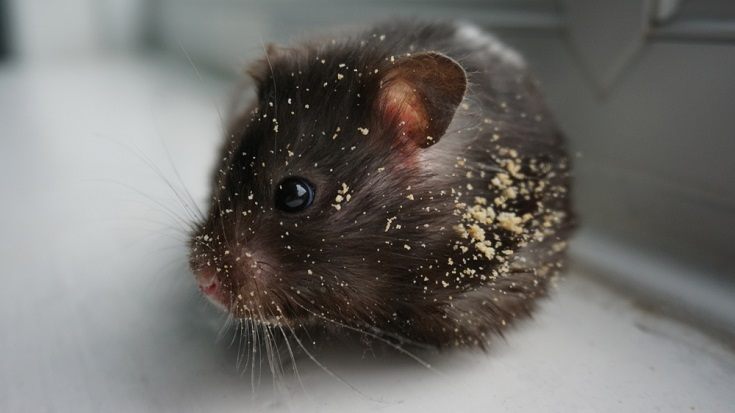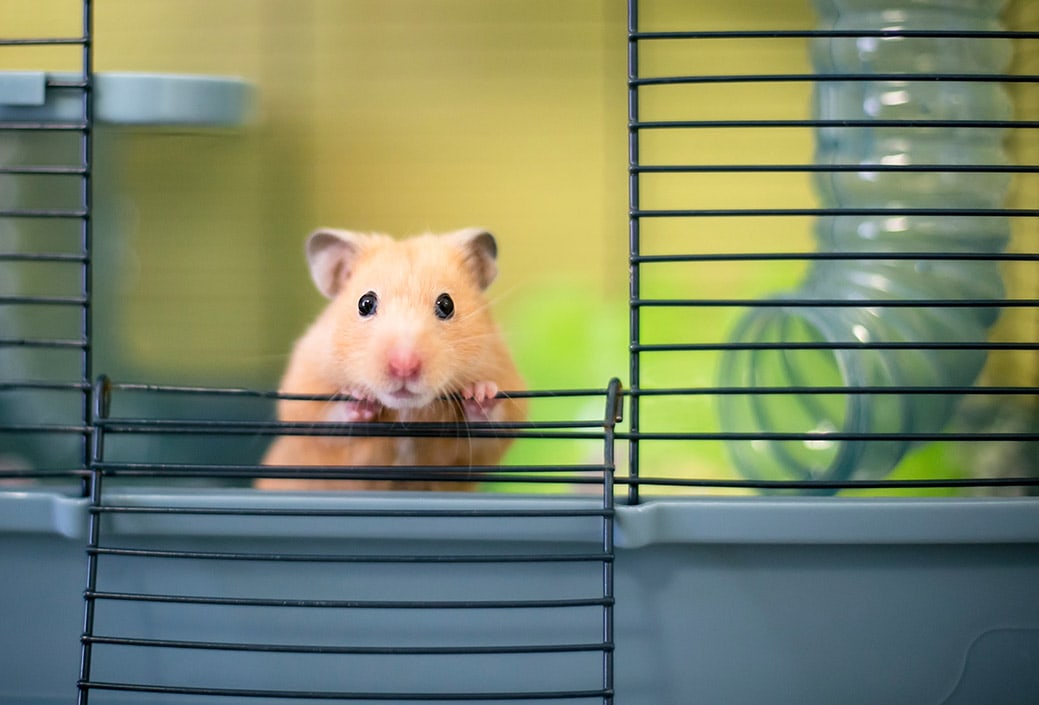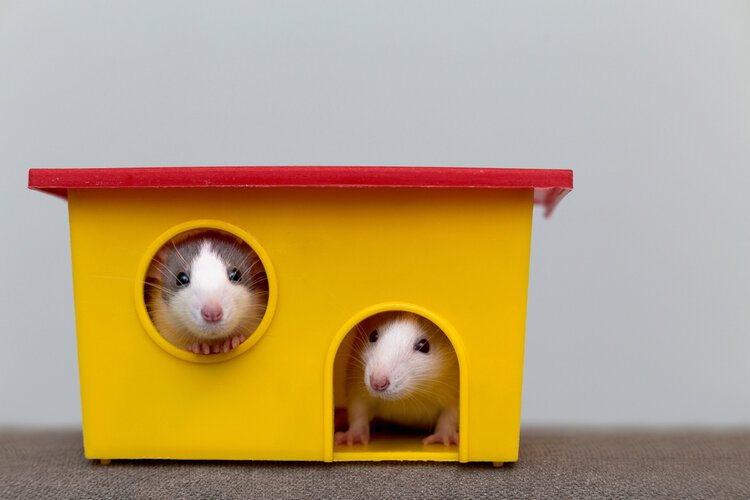
| Length: | 2–3 inches |
| Weight: | 1.5–2.5 ounces |
| Lifespan: | 2–2.5 years |
| Colors: | Agouti, cinnamon, sandy brown, white |
| Temperament: | Experienced hamster owners, and families without small children; can resist temperatures as low as -25°F |
| Best Suited For: | Sociable towards other hamsters, shy towards humans |
If you’re looking to own more than one hamster at a time, the Campbell’s Russian dwarf hamster might just be the best choice for you. Unlike some hamster breeds—i.e., the Syrian hamster—this little fellow can do rather well being around other hamsters. This is especially true if the hamsters were raised together.
They are, however, a bit more of a challenge to raise. But if you’re an experienced hamster owner, the Campbell’s Russian dwarf hamster could be a fun addition to your family.
Campbell’s Russian Dwarf Hamster: Before You Buy…
These are among the most commonly found dwarf hamsters. However, they’re also among the most confused between pet shops. If your hamster’s fur starts changing color in the winter, you’ve probably picked up a Winter White Russian dwarf. The two species actually share a few common names such as Djungarian or Russian dwarf hamster.
Campbell’s Russians normally have a less than friendly temperament towards people when compared to the Winter Whites, making them more difficult to tame. They are also among the most likely to bite or nibble out of any hamster breed.
But that shouldn’t distract you from getting a Campbell’s Russian—especially if you’re looking for a pet to handle minimally. They are so much fun to watch and observe! Each one of these little guys has their very own unique personality that’s evident in everything they do.
What’s the Price of a Campbell’s Russian Dwarf Hamster?
Like most hamsters, the cost of purchasing one is very affordable. You’ll find that the price of these hamsters varies from place to place, but you’ll be able to easily find one for less than $15. The bigger costs for raising these tiny furry friends come from the other essentials including food, enclosure, toys, and exercise equipment.
3 Little-Known Facts About the Campbell’s Russian Dwarf Hamster
1. They Are Named After William Charles Campbell
These hamsters were first collected in Inner Mongolia in the early 1900s by naturist William Charles Campbell. They were found outside a village known as Shaborte.
2. They Have Hairy, White Feet
These hamsters come with their own built-in boots. And that’s perfectly understandable if you look where they come from in the wild. They’re found throughout Central Asia and parts of Russia where it can get quite cold.
3. They Thrive in Captivity
Although the lifespan of this breed is pretty short, it’s actually much shorter in the wild. This is because in captivity it’s easier for younger hamsters to get the proper nutrition to grow and develop. In the wild, there is often a shortage of food, leading to premature deaths.

Temperament & Intelligence of the Campbell’s Russian Dwarf Hamster
Campbell’s Russian dwarf hamsters share a couple of common traits among hamster breeds. First, they are nocturnal creatures. This means that they’re very active at night and in the early evening. However, this breed has been known to have active spurts even in the middle of the day.
Secondly, they absolutely love to dig, tunnel, and burrow. This is how they live out in the wild, so it makes sense they’d enjoy it in captivity as well. Be sure to provide enough nesting and digging material. They’re also very fond of tunneling and tube toys.
Are These Hamsters Good for Families? 👪
If you come from a family with experience raising hamsters, then these shouldn’t be too much more difficult. However, if you’re picking up a hamster for the first time, this probably isn’t the breed you want. While hamsters are skittish by nature, the Campbell’s Russian dwarf hamster is especially so. Mishandling these critters is sure to land you with a couple of nips, and they’re more likely to slip in a child’s grasp. Also, they do come with more health problems than larger breeds.
Does This Breed Get Along with Other Pets?
These hamsters are extra skittish when it comes to larger pets. They don’t do well with cats, dogs, or unknown humans. But they can co-exist with one another.
This co-habitation ability is found much more often in dwarf variants of hamsters like Campbell’s Russians. However, you need to be careful in this regard. You should only keep them in same-sex colonies to minimize fighting and over-breeding. You also need to be vigilant when looking out for bullies. Hamsters have their own personalities and some of them are just mean to other hamsters. Keep an eye out for these troublemakers and separate them from the group as soon as possible.
Things to Know When Owning a Campbell’s Russian Dwarf Hamster:
Before tackling the challenge of owning a Campbell’s Russian dwarf hamster, you’ll need to understand some essentials.
Food & Diet Requirements 🥕
Campbell’s Russian dwarf hamsters are omnivores. They require a balanced diet of vitamins, minerals, and meat protein. All of this nutrition can be found in specially designed food pellets. And you can even supplement their diets with some fun snacks and treats.
But be forewarned, this breed can’t eat some of the snacks you can typically feed other hamsters. Almonds, celery, and tomatoes may be alright for some other breeds, but you’ll want to avoid giving these to your Campbell’s dwarf hamsters. And you should avoid garlic at all costs. Garlic is exceptionally poisonous to all hamsters.
Exercise 🐹
Exercise is a very important part of your hamster’s daily routine. They can become super-hyperactive and require something to keep them occupied. Your best bet here would be a hamster exercise wheel. It’ll allow them to burn off all that excess energy.
Also, make sure you have lots of bedding material in their cages. This breed loves nothing more than to tunnel and dig its way around. Having a larger enclosure will help to fulfill these needs as well.
Training 🎾
When you think of hamsters, performing tricks isn’t necessarily the first thing that comes to mind. If you’re looking for a pet that can perform a variety of different commands, do not get a hamster. However, hamsters aren’t as unintelligent as you’d think.
It’s not too difficult to really domesticate these rodents as long as you handle them daily. And by softly speaking their name to them, they can actually learn it and respond when called.
Grooming ✂️
You shouldn’t have to do too much grooming when it comes to your Campbell’s Russian dwarf hamsters. Like all other hamster breeds, they self-groom. And you might actually see this breed groom themselves more than others due to its poor eyesight.
Excess grooming by humans, though, can actually be somewhat harmful to your hamster. It can disrupt the natural oils produced and dry out your hamster’s skin and dull its coat. So better to sit back and watch your hamster take care of itself in this way.
Health and Conditions 🏥
Unfortunately, there are more conditions that plague this particular type of hamster than most others, so it’s important to be vigilant about checking your Campbell’s Russian dwarf for any ailments.
The first is glaucoma. Sadly, this particular breed is more susceptible to this eye condition. And there’s not too much that can really be done about it.
Most hamster breeds are very susceptible to diabetes, but the Campbell’s Russian dwarf takes that a step further. Diabetes can be averted by ensuring that your hamster eats a proper well-balanced diet.
Lastly, the Campbell’s Russian dwarf has a genetic predisposition that prevents the metabolization of carbohydrates and lipids. This can cause tumor development upon sexual organs and mammary glands.
On a less serious note, the Campbell’s Russian dwarf has very poor eyesight and depth perception compared to the majority of other hamsters. This is why they have many more scent glands around their face and rectum. Often you’ll see the Campbell’s Russian dwarf groom itself in unfamiliar places. This is done in order to add their scent to their feet. The feet then create scent trails that can be followed for up to eight days.
Male vs Female
As observed, there are really no noticeable differences between male and female hamsters. The only real thing you need to be aware of regarding the sex of the hamster is when you’re housing a group of them. It’s much better to house a group of males than females. Female hamsters tend to fight much more often than males.
Summary
Although these can be one of the trickier hamster breeds to raise, the Campbell’s Russian dwarf hamster can be a whole bunch of fun. They do love to socialize with their peers (assuming they get along with them) and develop their own unique personalities.
And if you live in a colder environment, these could be a great little pet to keep without worrying so much about freezing out, provided they have ample bedding, of course. However, due to their smaller and more nimble nature, we don’t recommend these for smaller children. They require a little bit more finesse than larger breeds such as the Syrian hamster.
Featured Image Credit: ztsaries, Shutterstock











